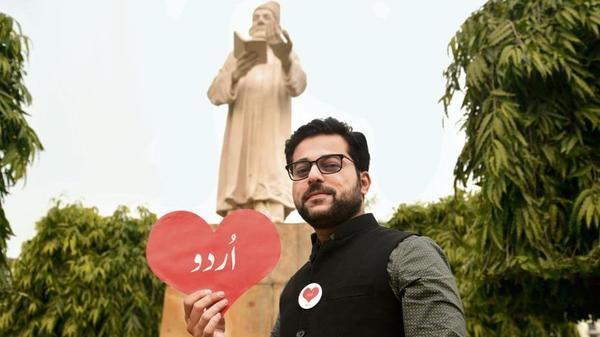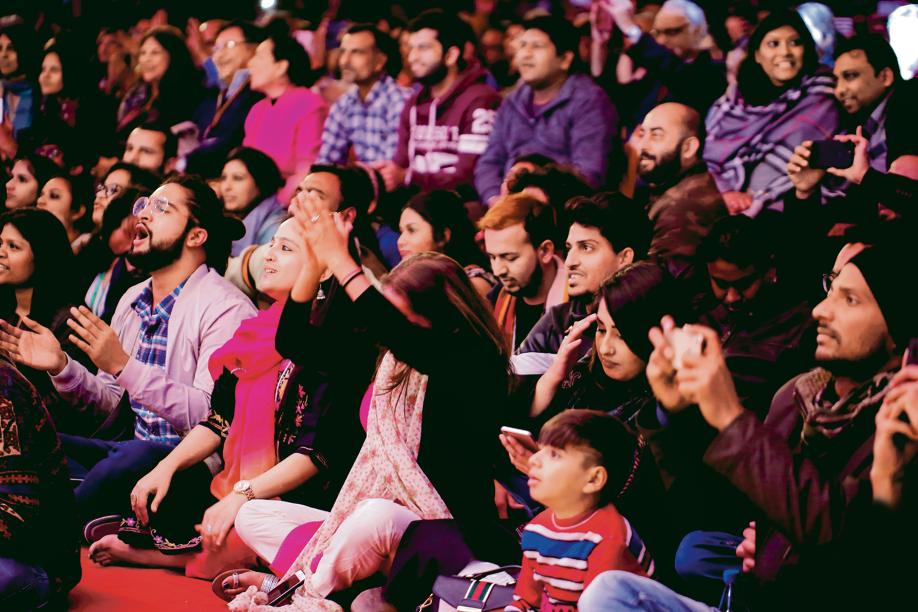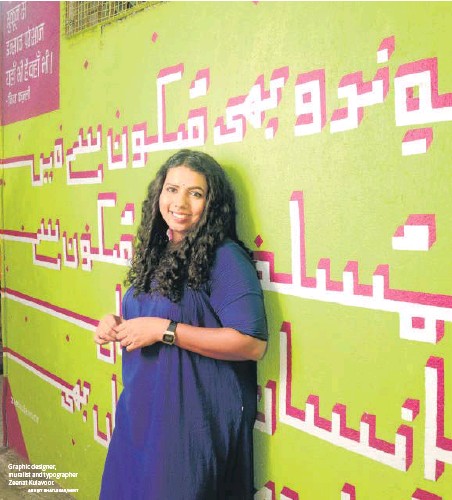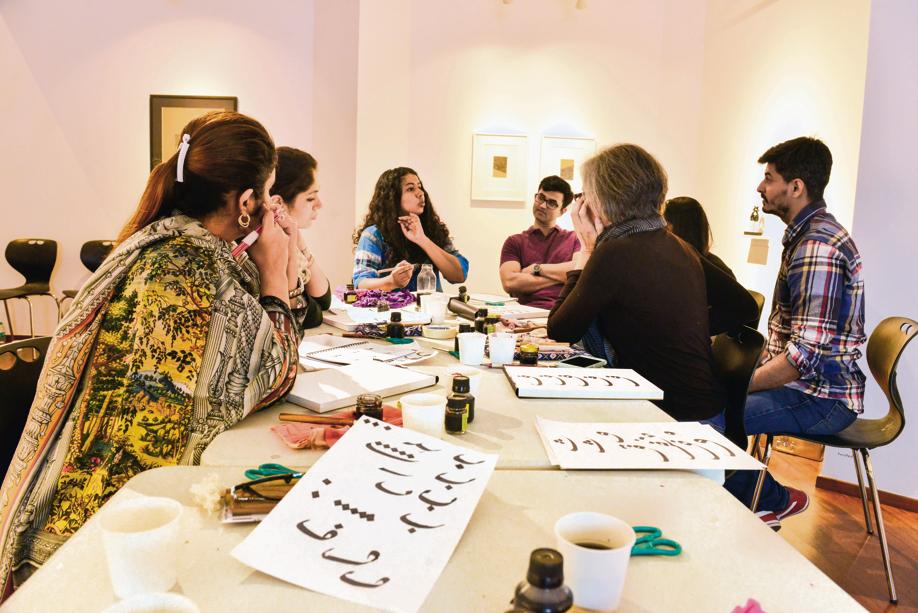Mumbai, MAHARASHTRA :

- It’s got tehzeeb, romance and nuance, drawing a growing number of urban Indians to it
- Urdu is in our lives even if we don’t realize it. But it is only recently that this love for the sound of Urdu has extended to its script
It’s on a Tuesday evening in January, under a canopy of incandescent bulbs, that I receive my first lesson in Urdu: the difference between alcohol and mirages.I am part of a small mehfil gathered in the courtyard of Prithvi Theatre in Mumbai. People greet each other with adaab, and the bonhomie that strangers share is palpable.
In this session of a monthly Urdu meet-up called Mehfil@Prithvi, we are listening to people read ghazals and nazms by the late Pakistani poet Fahmida Riaz. She lived in exile in India for almost seven years during Zia-ul-Haq’s rule, and died in November in Lahore. Riaz wrote heart-wrenching lines on female desire and communalism, such as:
Sarab hun mein
Teri pyaas kya bujhaungi
Urdu scholar Ilyas Shauqi, who delivers the lines at the mehfil, explains to me later that sarab means mirage, an illusion, and is often mistaken by non-Urdu speakers for sharab, or alcohol. “Urdu is like this—you have to pay attention to the pronunciation,” he adds.
Such is my introduction to Urdu, a language that appears to conceal more than it reveals. Writer Annie Zaidi, who often leads the Mehfil@Prithvi sessions, says that while Urdu runs in her family, she learnt to write the Nasta‘līq script as recently as 2017. Annie’s motivation was access, both to the past and the present. “I always wanted to know more about Urdu literature, and there is only so much that you can understand through transliterations. Besides, my grandfather (Ali Jawad Zaidi) is an Urdu writer, and it was a shame that I couldn’t read his works in the original. Urdu should have been my mother tongue but, as things stand, I am more fluent in Hindi,” she says.
Despite her familiarity with spoken Urdu, the experience of learning the script was nothing short of confounding. She says, “The ligature—the manner in which letters bond with each other in Urdu—was particularly tough. The letters change shape as they form a word and very few phonetic cues are used. I had a friend teach me that over WhatsApp.”
Urdu’s idiosyncrasies are both its charm and challenge, as a growing number of newly forged admirers among urban Indians will testify.
According to 2011 census data on mother tongues released last year, Urdu dropped from sixth to seventh position, showing a drop of 1.58%. The only other language to record a fall was Konkani. Yet Urdu has found new takers. Many of them are spurred on by an interest to read Urdu texts in the original, rather than translations or transliterations. Some want to learn the script for research, for design, or to write poetry. For others, like Annie, it is the chance to revisit their roots. In this mix are non-Muslims, non-Urdu-speaking Muslims, and Urdu-speaking Muslims who never learnt the language formally.
The country’s non-Urdu-speaking population has been nourished for a long time on a literary diet of some of the best prose, poetry and lyrics that the language offers. Bollywood songs, theatre, even the stray couplets that break the monotony of endless Twitter feed scrolls—Urdu is in our lives even if we don’t realize or acknowledge it. But it is only recently that this love for the sound of Urdu has extended to its script as well. Mumbai-based theatre practitioner Danish Husain, who curates the monthly Mehfil@Prithvi and is known for his dastangoi performances, says that while the interest in Urdu has always been there, what he has seen in the last couple of years is “the interest in the text”, whether it’s people reading works intently or dramatizing them.
The revival is linked to the proliferation of online portals and Urdu-themed events in urban centres, such as shayari clubs, Urdu readings and calligraphy classes. Prominent among them is the Noida-based Rekhta Foundation. Through its website Rekhta.org, it offers an Urdu word-of-the-day along with a dictionary (also delivered to users on WhatsApp); offline, it organizes one of the biggest Urdu festivals in the country, Jashn-e-Rekhta. The festival, which debuted in Delhi in 2015, saw over 15,000 visitors; in 2018, the numbers rose to 170,000 (figures from the Rekhta Foundation ).

In 2017, following multiple requests from festival attendees and online users, the foundation started a beginner’s Urdu course, with calligraphy and poetry appreciation thrown in for good measure. Simultaneously, it also launched an online education portal, Aamozish.com, through which 35,000 people have studied Urdu so far.
Sarover Zaidi, an anthropologist based out of Mumbai and Delhi who works on religion, architecture and social spaces, believes this growing interest in Urdu is a natural progression of the impact of social media and online resources, which have provided people with more access to the script, something that wouldn’t have been easy even a decade ago. “A large number of people have always been interested in Urdu—even those who did not grow up in cultures where Urdu was accessible. But more people are now responding to it, whether it is their interest in the poetry, literature, or the culture it represents—they are interested in the poetics and politics of it. They want to make a statement,” she says.
Writing or drawing?
To explore what’s driving urban Indians to the language, I attended an Urdu calligraphy workshop at Mumbai’s Tarq gallery in December. I realized that learning Urdu through the calligraphic Nasta‘līq script requires nothing less than absolute dedication.

The workshop was conducted by Zeenat Kulavoor, a 30-year-old graphic designer and typographer, who has created two murals in Urdu. Both were made in 2017, on the premises of a repurposed mill in Mumbai. One of them is “pehle aap“, evoking the Lakhnavi tehzeeb—the courteous mannerisms once associated with Lucknow. The other mural bears stirring verses that only the mind of poet Nida Fazli—a Padma Shri awardee and staunch critic of the Partition—could have conjured up. As a muralist, Kulavoor refers to the characteristics of not just Urdu but of the cultures that use this language. The reason people are learning Urdu is almost the reason why some of us study French in India—we also consume the culture the language represents.
Kulavoor started learning Urdu at the Sir JJ School of Art in 2008, when she was part of a class project on creating a calligraphy manual. “We had to choose a language from those printed on the Indian currency note. Creating the manual meant understanding the script, breaking it down and then showing users the steps to write the script,” recalls Kulavoor. She arrived late for class, and the other languages were taken, leaving only Urdu. “That’s how Urdu found me,” she says.
Kulavoor tried to find an Urdu mentor—but on the internet, the only available resource she could find at the time was a bunch of videos on Arabic calligraphy.
A decade later, she decided to organize workshops focusing not on linguistics but on the form and design elements of the Urdu alphabet. For most of the participants at her 6-hour, beginner-level workshops were looking for something specific—designing calligrams for their projects, for instance.
Entering the world of Urdu calligraphy, however, means unlearning. One of the participants had been meditatively painting a series of be—the second letter of the Urdu alphabet—but realized much later that instead of going from right to left, as Urdu demands, she had been writing instinctively left to right.
Keeping the language alive
Kulavoor’s calligraphy classes come at a time when the generation of veteran kaatibs (calligraphers), the ones who populated Old Delhi’s lanes and Mohammed Ali Road in Mumbai, is fading. On 30 January, one such noted figure, Shilp Guru Irshad Hussain Farooqi, a resident of Delhi, died.

Shipra Dutta, 45, got reacquainted with Urdu to save a family legacy. Dutta is a fourth-generation calligrapher—her great-grandfather served as an accountant in the court of Mughal emperor Bahadur Shah Zafar. The story in her family is that he was chosen to maintain the accounts not because of his mathematical skills, but rather for his penmanship in mahajani (a mercantile script) and thuluth (an Islamic calligraphic script). When Dutta was offered the chance to calligraph a set of Urdu poems for a Kashmiri pashmina-weaver, she realized she also wished to learn what the words meant. “Urdu is led through the qalam (pen), and there is a visual pleasure in watching it move on paper. It is essentially a dance of hairline strokes and thick strokes, a jugalbandi,” she says.
A similar interest drew Dhwani Shah, a 31-year-old designer for publisher Tara Books. She signed up in October for Inktober, an annual Instagram hashtag series in which users respond to a word prompt through visual interpretations. Shah drew Urdu translations of the English prompts. She picked up Urdu as a hobby while studying design at Bhasha Bhavan in Gujarat Vidyapeeth, Ahmedabad. Now based out of Chennai, she believes the only way she can keep her interest alive is to go old school—handwritten letters. She is a member of Quillpal.com, a site that helps people make pen pals in the age of blue ticks and DMs. Shah wanted to write her letters in Urdu, and Quillpal luckily matched her with a pen pal fluent in the language.
As with her writing, Shah also tries to infuse her everyday conversations with a dose of Urdu. “Urdu has several words that are poetic and beautiful, but I try to use ordinary words like mehez (merely), fizool (useless), zikr (mention). I can sneak them into conversations without sounding pompous,” she says.
While calligraphy is one means of popularizing the script, its greatest presence is in the digital form. Urdu printing presses have been on the decline, and have been replaced by a number of apps and digital tools that enable people to type away in Urdu on devices. Nasheet Shadani, a 32-year-old Delhi-based advertising professional, has taken it a step further, harnessing the power of memes to convey some fun facts about Urdu. “People are still learning Urdu in a very 1970s method and I want to make it more contemporary,” says Shadani.
In 2015, he started a social media project called Ishq Urdu, which mainly operates through Instagram and Facebook. Look it up and you will find some thought-provoking posts—what would Bollywood dialogues be without Urdu? Could “Mogambo prasann hua?” ever have the same effect as “Mogambo khush hua?”
Shadani’s latest venture introduces the Urdu alphabet to his general audience through a unique series of posts. On a background of pop colours, he designs phrases such as “Hey, what’s up?” or “Good afternoon” where “hey” and “noon” are, in fact, Urdu alphabets. It’s a simple but smart mnemonic device that he prints on a limited edition series of badges and T-shirts.
Delhi-based historian and scholar Rana Safvi, whose eponymous blog is a great resource for all things Urdu, says: “Urdu uses the same grammar as Hindi. Not that of Farsi.” In her blogpost “My Name Is Urdu And I Am Not A Muslim”, Safvi traces the evolution of the language and recalls Australian linguist Peter Austin’s observation that “Urdu and Hindi have the same roots in the emerging Indo-Aryan language varieties spoken in an area centred on Delhi, and specially the variety called Khari Boli, which spread throughout India under the Muslim armies of the Delhi Sultanate (13th to 15th century).”
In present-day India, Safvi notes: “Associated as it is in people’s eyes with Muslims, it has become nothing but a trap for vote-bank politics, unkept promises and empty dreams. The only silver lining is that it still lives in the hearts of many across religious lines, in our Hindi films and TV serials, the crowds flocking to mushairas, and the number of sites which provide SMS lines on the internet. ”
Love it, hate it
So, what’s the culture that Urdu signifies? That of a genteel past or a polarized present?
The recent Twitter hashtag movement #MyNameinUrdudrew attention to a prevalent prejudice against the Urdu script. Using this hashtag, Twitter handles sported user names in Urdu—many among them non-Urdu speakers. It was a statement against communal hatred and incessant trolling, but there was a catch—the Google transliteration app didn’t always succeed accurately. Those familiar with Urdu came forward on Twitter to do the job instead.
In 2016, signboard painter Akhlaq Ahmad and French street artist Swen Simon were forced by a small group of people in Delhi to deface their mural of an Urdu couplet in praise of the city. Their lines read: Dilli tera ujadna, aur phir ujad ke basna. Woh dil hai toone paya, sani nahi hai jiska. It sounds like Hindi, except it was written in Urdu. The group reportedly questioned the artists’ Nasta’līq script and asked them to replace it with the words “Swachh Bharat Abhiyan” and “Narendra Modi”, in Hindi. They labelled the artists “Lahoris”.
The Delhi government, however, has been attempting to promote Urdu. In November, it held Jashn-e-Virasat, a celebration of tehzeeb, with the support of the Urdu Academy. Previously held at Jama Masjid, Old Delhi, this edition took place at Central Park in Connaught Place, a location which brought the event, and the language, closer to a cosmopolitan crowd. But Asad Ashraf, the founder of a community project called Karvaan India, is attempting the reverse—getting people closer to the localities where Urdu is used.
Karvaan’s office, situated in Delhi’s Ghaffar Manzil, a Muslim-dominated area, houses a library and a workspace for creative professionals, writers and “fellow travellers”. In the past year, Karvaan has increased its programming, focusing on topics pertinent to its immediate community, such as the ghettoization of Muslims and talaq, while also opening its doors to a wider public.
It is with the same intent that Ashraf launched Urdu Hai Jiska Naam last year. The title of the weekend classes comes from a famous sher by Urdu poet Dagh Dehlvi. Last year, 35 participants enrolled in the class. This year, there were 300 applicants, but Karvaan has resources enough to register only 100, despite doubling batches. Of these, only eight are Muslims.
The class is conducted by entrepreneur Tanzil Rahman, an Indian Institute of Management Bangalore graduate. He recalls the time when he was first taught the Urdu alphabet in school. “We practised on a wooden plank which functioned as a slate called a takhti, as big as two MacBooks placed side-by-side. On this, we wrote the alphabet in ink. We did this before we switched to paper because kushkhat, or neat handwriting, is very important,” he explains.
As an Urdu mentor, Rahman’s method is different. He prefers to keep the course functional and contemporary, and helps participants recognize Urdu in its popular usage, from film dialogue to signboards at railway stations. “Take Nizamuddin station, for example. Isn’t the iconic yellow signboard a great way to learn how Nizamuddin is written in Urdu?” he says. He delves a little further into the intricacies of Urdu, the manner in which vowel sounds are dropped and how you understand words by contextualizing them.
He says Urdu is taught now only in some public schools but rarely in private schools. “So people have to make use of independent courses like these. The classes are useful also for Muslims whose mother tongue is Urdu because while many may speak the language, not all know how to write it,” he adds.
Savio Pashana, 30, a designer and a spoken word performer, is part of a growing circle of spoken word poets in Thane who organize performances under the banner of Poetry Tuesday. Some of the members performed their Urdu pieces in January at the Spoken Fest in Mumbai. “The biggest disservice we have done to the language is to give it a homeland in Pakistan alone. But think about it—Bhagat Singh wrote letters to his family in Urdu,” he says.
Urdu was once used extensively by Hindus as well as Muslims, and even the British, though it may be mainly Muslim communities that are keeping it alive on a daily basis today. By encouraging participants to come closer to minority communities that still use Urdu as their mother tongue, Karvaan is suggesting that the secularization of Urdu need not mean that it makes Muslims invisible.
Shaikh Aquil Ahmad, director of the National Council for the Promotion of Urdu Language (NCPUL) in Delhi, says, “People are not learning it for religious reasons alone. It’s because Urdu zubaan mein behad mithaas hai (it is a very sweet language).”
Beyond the politics
“A nukta can make a huge difference,” says Mumbai resident Shirlyn Galbao, 44, referring to the wily dot that is the cornerstone of the Urdu alphabet. Galbao says she was already familiar with the lilt of Urdu, but the urge to master the language was driven by two sources—her job as a voice-over artist and a monthly baithak. Galbao wished to perfect her talafuz (pronunciation), particularly because several Hindi commercials, especially on radio, are sprinkled with Urdu words. Her search led her to Katha Kathan.
Katha Kathan, a series of dramatized readings of Urdu’s best literary names, was initiated by former ad-man Jameel Gulrays, after he felt the need to share Urdu’s literary wealth in a time when it is being offered in fewer schools across India as a second language—they would rather offer French, German, even Japanese. Gulrays has translated several short stories by Urdu writers.
He disliked the Nandita Das film Manto, finding it an inauthentic representation of the Urdu writer, and chooses to commemorate the writer across baithaks—celebrating Manto’s “Bambai”, his short stories and his Marathi translations. Gulrays’ readings are available on YouTube; he has made 1,200 videos so far.
Galbao started with these baithaks and eventually found a mentor in Gulrays, who teaches with a blackboard and a list of primary school textbooks, and recommends reading Urdu newspapers. Galbao has piles of Urdu newspapers, which never fail to catch the attention of her friends. “My Muslim friends don’t speak Urdu and often wonder if I will teach them Urdu when they see the newspapers,” she laughs, adding that some acquaintances have asked her why a Catholic should wish to study an “Islamic” language.
As Shadani says, a revival need not be literary or political. Sometimes, a college student may want to study Urdu simply to flaunt it, especially when it comes to matters of the heart. As Ahmad says, “Urdu is mohabbat ki zubaan—the language of love.”
Urdu in your city
1. The National Council for the Promotion of Urdu Language (NCPUL) offers a free diploma as well as certificate courses in Urdu in 1,359 centres across India. It has been systematically scaling up centres; currently, 57,301 students have registered for these courses. Additionally, the NCPUL offers calligraphy classes at select centres.
Urducouncil.nic.in
2. The Zabaan Language Institute at Kailash Colony, Delhi, offers two courses in Urdu reading and writing, a basic and a secondary. It also offers home tutors for private classes if you are willing to pay travel costs.
Zabaan.com; 011-40564840
3. The Hindustani Prachar Sabha at Charni Road, Mumbai, offers three levels of programmes. The basic beginner’s certificate is an year-long course.
Hindustanipracharsabha.org; 022-22812871
4. Kitab Khana, one of Mumbai’s largest book stores, has a modest shelf dedicated to Urdu writing. You can browse through it, and if you spot co-owner Samir Somaiya around this section, don’t be surprised. In 2017, Somaiya learnt Urdu from a mentor who also advises the store on the Urdu titles they should be stocking.
Kitabkhana.in; 022-61702276
5. What Che Guevara was to T-shirts in the 20th century, the late poet Jaun Eliya is to Urdu lovers. Sample these and other contemporary designs, all dedicated to Urdu luminaries, at Shiraz Husain’s Khwaab Tanha Collective.
@khwaabtanhacollective on Facebook
6. On Twitter, @Rekhta and Rana Safvi’s @urdualfaz are dedicated to teaching Urdu, one word at a time. You may also want to check out @TimeUrdu, a linguistic project that promotes the language.
source: http://www.livemint.com / Live Mint / Home> Latest> Trending> My Reads / by Benita Fernando / February 03rd, 2019








